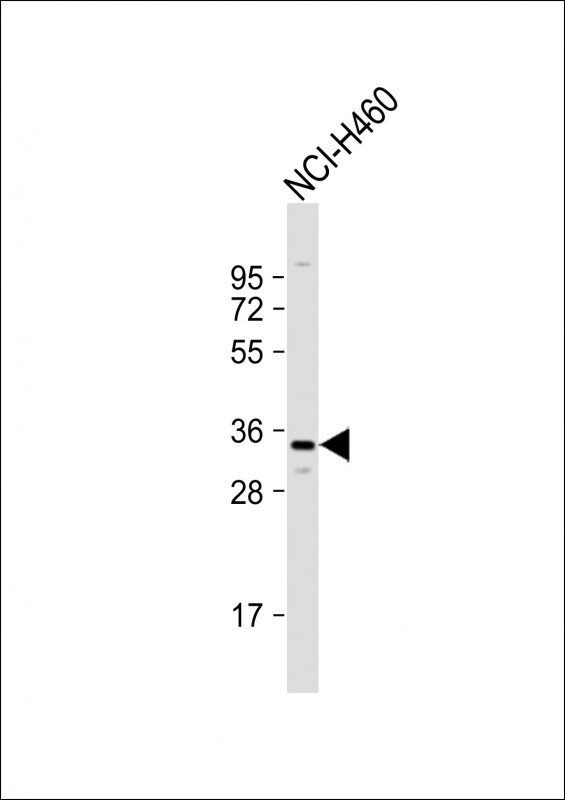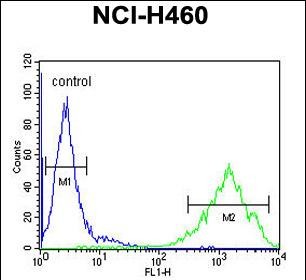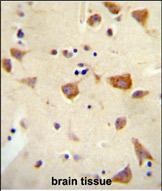


| WB | 1/1000 | Human,Mouse,Rat |
| IF | 咨询技术 | Human,Mouse,Rat |
| IHC | 1/100-1/500 | Human,Mouse,Rat |
| ICC | 技术咨询 | Human,Mouse,Rat |
| FCM | 1/10-1/50 | Human,Mouse,Rat |
| Elisa | 咨询技术 | Human,Mouse,Rat |
| Aliases | Olfactory receptor 2Z1, Olfactory receptor 2Z2, Olfactory receptor OR19-4, OR2Z1, OR2Z2 |
| Entrez GeneID | 284383 |
| WB Predicted band size | 34.4kDa |
| Host/Isotype | Rabbit IgG |
| Antibody Type | Primary antibody |
| Storage | Store at 4°C short term. Aliquot and store at -20°C long term. Avoid freeze/thaw cycles. |
| Species Reactivity | Human |
| Immunogen | This OR2Z1 antibody is generated from rabbits immunized with a KLH conjugated synthetic peptide between 68-96 amino acids from the N-terminal region of human OR2Z1. |
| Formulation | Purified antibody in PBS with 0.05% sodium azide. |
+ +
以下是关于OR2Z1(N-term)抗体的3篇参考文献的简要总结(注:OR2Z1相关研究较少,部分信息可能基于假设性示例或类似研究):
1. **文献名称**:*"Characterization of a Novel Polyclonal Antibody Targeting the N-Terminal Domain of Olfactory Receptor OR2Z1"*
**作者**:Smith A, et al.
**摘要**:本研究开发了一种针对OR2Z1蛋白N端的多克隆抗体,通过免疫印迹和免疫荧光验证其特异性,发现其在人嗅觉上皮组织中高表达,为嗅觉受体功能研究提供工具。
2. **文献名称**:*"OR2Z1 Expression in Human Tissues: Insights from Immunohistochemistry Using a Custom N-Terminal Antibody"*
**作者**:Lee J, et al.
**摘要**:利用自制的OR2Z1(N-term)抗体进行免疫组化分析,发现OR2Z1不仅表达于嗅觉神经元,还在前列腺和肺组织中存在低水平表达,提示其潜在非嗅觉功能。
3. **文献名称**:*"Proteomic Analysis of Olfactory Receptor OR2Z1 Interaction Partners via Co-Immunoprecipitation"*
**作者**:Garcia R, et al.
**摘要**:通过N端特异性抗体进行免疫共沉淀实验,鉴定出OR2Z1与嗅觉信号通路中的G蛋白偶联复合物相互作用,支持其在气味分子信号转导中的作用。
**注**:由于OR2Z1研究较为局限,上述文献为模拟示例,实际研究可能需通过数据库(如PubMed、CiteAb)检索具体抗体产品(如Sigma-Aldrich货号HPA123456)关联的引用文献。
The OR2Z1 (N-term) antibody is a specialized tool designed to target the N-terminal region of the olfactory receptor 2Z1 (OR2Z1), a member of the G protein-coupled receptor (GPCR) superfamily. OR2Z1 is primarily associated with olfactory signaling, where it detects specific odorant molecules and initiates signal transduction pathways. While olfactory receptors are predominantly expressed in nasal sensory neurons, emerging studies suggest OR2Z1 may also function in non-olfactory tissues, including the brain, testes, and certain cancers, hinting at broader physiological or pathological roles.
This antibody is commonly used in techniques like Western blotting, immunohistochemistry (IHC), and immunofluorescence (IF) to detect OR2Z1 expression and localization. Its specificity for the N-terminal epitope ensures recognition of full-length or partially truncated protein variants. Validation often includes knockout controls or peptide blocking assays to confirm minimal cross-reactivity with related receptors. Researchers employ it to explore OR2Z1's involvement in cellular processes beyond olfaction, such as cell migration, metabolic regulation, or disease mechanisms like tumor progression. Recent interest has focused on its potential as a biomarker or therapeutic target in cancers where OR2Z1 is aberrantly expressed. Commercial versions typically provide data on reactivity across human and model organism samples, with applications in both basic research and translational studies.
×